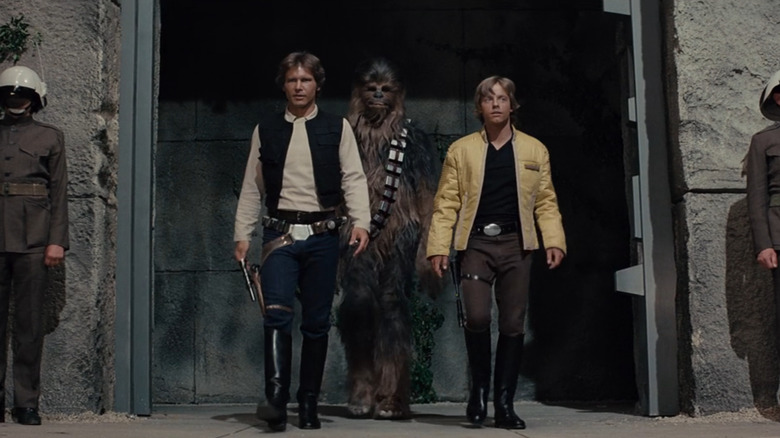Andor's BBY Dating System Explained
Time is a fleeting concept — one that becomes even more amorphous when considering how it might function across an entire galaxy. According to NASA, our Milky Way galaxy is thought to contain somewhere between 100 to 400 billion stars, and measures 100,000 light years in length. This means that if one was so inclined to travel from one edge of our galaxy to another, it would take 100,000 years of traveling at the speed of light to reach the other side. Needless to say, the vastness of space can be something of a daunting prospect with regards to the conventions of time.
"Andor" is Disney's latest romp through its flagship "Star Wars" universe, chronicling how Cassian Andor (Diego Luna) becomes the die-hard rebel leader featured in "Star Wars: Rogue One." Time-wise, "Andor" is a prequel television series that takes place before the original "Star Wars" trilogy but after the "Star Wars" prequel trilogy, placing its story smack dab in the midst of a fermenting rebellion. More specifically, the very first moments of "Andor" see Cassian walking into a settlement on Morlana One, and the show mentions that this is taking place during "BBY 5."
Obviously, that denotes a year. However, what exactly does BBY 5 mean?
BBY denotes the time before a massive event in Star Wars history
In real life, our calendar categorizes years as either "B.C." or "A.D.," which is a system heavily influenced by Christianity. As noted by Live Science, B.C. stands for "before Christ," while A.D. is Latin for "anno domini," which translates to "in the year of the lord." So, what does "BBY" mean in "Star Wars?" Could it mean "before Baby Yoda," for example?
Unfortunately, no, Grogu is not part of the Star Wars dating system. However, BBY does reference an incredibly historical moment in the "Star Wars" universe: the Battle of Yavin.
For the non-hardcore "Star Wars" fans, Yavin is the planet that hosts the secretive base of the Rebel Alliance in the first "Star Wars" movie. The Battle of Yavin actually refers to the skirmish that results in the destruction of the first Death Star. This means that "Andor" takes place five years before this momentous event — a victory that Cassian Andor is partially responsible for, on account of him aiding in the theft of the original Death Star plans during the events of "Rogue One." By stealing these plans, Andor and the rest of his team provide the Rebel Alliance with the means to destroy the Death Star, which otherwise would have become yet another symbol of Imperial oppression. From that point on, years in the "Star Wars" universe are denoted as "Before the Battle of Yavin," aka BBY, or "After the Battle of Yavin," aka "ABY."
How do Andor's characters refer to the year in which the series takes place?
Cassian Andor and the rest of the characters featured throughout "Andor," of course, do not know they exist in the year BBY 5, given that the Battle of Yavin has yet to occur.
According to a Wookiepedia entry about time, which cites canonical texts like the 2015 book "Star Wars: Absolutely Everything You Need to Know," galactic authorities at one point considered year zero to be the end of the Old Republic era featured in, for example, the acclaimed "Star Wars" video game "Knights of the Old Republic." For what it's worth, the way time passes on what was once the galactic capital Coruscant is akin to how time passes on Earth, meaning that a standard year in the "Star Wars" universe similarly consists of 365 days of 24 hours.
The Old Republic era, meanwhile, ends around BBY 1000. So, if Cassian indeed uses the system that considers the end of the Old Republic as year zero during the events of "Andor," he likely understands himself to exist somewhere around the year 995. Some time after the Battle of Yavin, the BBY/ABY system is introduced to the "Star Wars" universe in-canon, eventually granting its inhabitants the same timekeeping device frequently shown to viewers.


